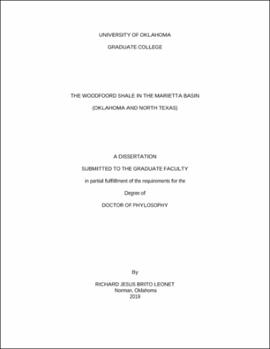| dc.description.abstract | A geologic characterization of the Woodford Shale in the Marietta Basin has never been published due to the very limited data in the basin. The primary goal of this dissertation is to identify, analyze and interpret the characteristics of the Woodford Shale formation in the Marietta Basin in southern Oklahoma and northern Texas using recent available core data, in conjunction with well logs and production data. A second related goal is to apply the knowledge and methods from Woodford Outcrops to identify ideal target intervals in the subsurface. The applied methodology includes the description of the cored section to set the stratigraphic framework for the integration of several type of data (XRD, XRF, SEM, EDX, RockEval, VRo, and Rebound Hardness), correlation of the key stratigraphic sections across the basin using well log data to generate structure and thickness maps of the most significant intervals, followed by estimating ultimate recovery (EUR) in the Woodford producing wells in the basin. Core analysis allowed the identification six significant lithofacies: Siliceous Mudstone (SM), Siliceous Shale (SS), Black Chert (BC), Argillaceous Shale (AS), Green Claystone (GC), and Dolomitic Mudstone (DM). Combining facies associations with core gamma-ray log, and X-Ray Fluorescence profiles provided evidence to interpret a stratigraphic sequence. The Maximum Flooding Surface (MFS) of the section corresponds to the middle of the stratigraphic section with the highest gamma-ray peak and it is linked to the condensed section dominated by the AS facies. This surface separates two primary systems tracts in the Marietta Basin: The Transgressive Systems Tract (TST) in the lower and middle section and the Highstand Systems Tract (HST) in the upper section. These two system tracts correlate to outcrop sections in the Arbuckle Mountains. Based on RockEval, TOC in the section ranges from 2.93% to 9.75%, dominated by Kerogen Type II. The average thermal maturity based on Vitrinite Reflectance is 0.79%Vro. Rebound Hardness data show that the high quartz content BC and SM facies are harder rocks than the quartz-poor AS and SS facies. Vertical Mineralized Fractures are bed bounded by clay-rich beds and only present within the SM beds. The paragenetic sequence of this Woodford section is very complex, with several diagenetic alterations in fractures and matrix. The top of the Woodford Shale ranges from as shallow as 5000 feet in the NW side of the basin, to as deep as 17000 feet in the SE. Gross Woodford Shale thickness ranges from 50 feet to 300 feet. Combining good Reservoir Quality (RC) properties like organic richness (TOC) and good Completion Quality (QC) properties like thin interbedded hard/soft beds to improve high fracture density generation helps map the preferred target interval. This "target interval" was correlated from outcrops and core into the basin, is stratigraphically placed above the MFS and below the base of the Chert-dominated interval in the Marietta Basin Woodford section. The Decline Curve Analysis shows average EUR of 90,000 bbl./1000ft lateral; therefore a 5000-foot lateral unbounded well (one section) could produce an average 450,000 bbl. of oil and 1 Bcf of gas. I show that EUR directly correlates with thicker "target intervals" (>80 feet) in the Woodford section and with deeper depth due to higher reservoir pressure support. I believe this dissertation provides the first published comprehensive study of the Woodford Shale in the Marietta Basin and hope it will guide not only scientific research but also future exploration and development of this play the Marietta Basin. | en_US |
